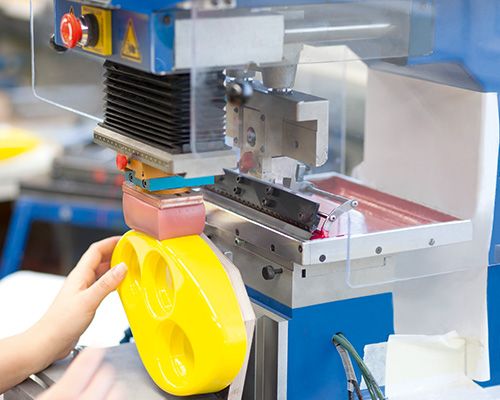Pad Printing
Pad printing, also known as tampography, is an indirect printing technique that transfers ink from a printing plate onto a variety of different surfaces using a silicone printing pad. This printing process take a 2D image and transferrs it with ink onto a 3D object.Pad printing has developed into one of the most important processes for printing on plastic objects. The advantage of this unusual pressure transfer is the deformability of the silicone rubber pad, which allows it to print on curved surfaces (convex, concave, or irregular).

How Pad Printing Works
There are three important pieces that allows the pad printing machine to work the way it does: the etched plate (also known as a cliché), the ink or ink cup, and the silicone printing pad.
The ink cup hold the ink and moves over the etched plate. This puts a small amount of ink into the etched design of the plate. Then the silicone printing pad is moved over top of the etch and presses into it, picking up the ink design onto the silicone pad. This pad is then moved over top of the product to be printed, where it is pressed and the image is transferred.
Because silicone is durable, it can be formed around many different types of surfaces. This means it can print on concave surfaces, such as a plate, convex surfaces, such as a pen, and overall uneven surfaces.
The Three Main Components
The Silicone Printing Pad is the part of the machine that transfers the ink. This transfer mechanism compresses the pad into the ink-filled etch to "pick up" the image before it transfers the image to a product. These silicone pads can be made in a variety of different strengths, shapes and sizes. These variations all depend on the application and the artwork.
The Ink Cup is the housing mechanism for the the ink. This mechanism slides over the cliché to leave a small amount of ink in the etch, which will later be picked up by the printing pad. There are three parts to the ink cup: the flood bar, the ink tub, and the doctor blade.
One method works as follows: there is a reservoir of ink, the flood bar draws ink from it onto the etched plate, and the doctor blade wipes the plate clean so that only ink remains in the etch.
In separate method, there are sealed ink cups which are sealed and act as the flood bar, ink tub, and doctor blade all in one. This sealed ink cup also includes a polished cereamic ring, which provides a seal against the cliché.
The Etched Printing Plate (cliché) is what holds the etch, or image, to be printed. The process of etching the plate can be done either with photopolymer or with laser etching.
Durability
ability to print on uneven or irregular surface
Detailed
ability to print high precsion details for small logos, text, or images
Cost-effective
reduced need for multiple printing runs
Variability
able to print with a variety of different inks
Advantages of Pad Printing
- Durability
- Precision and Detail
- Cost-Effective
- Variability
One of the best features of pad printing is its ability to print on uneven surfaces. This allows us to print on surfaces such pens and other promotional items.
The plates can also be etched with fine details, which allows us to print our small logos, text, and images in a detailed manner.
Pad printing has the ability to print in multiple colours with one pass, reducing the need for multiple print runs. This makes the process cost-effective and ideal for printing large batches of items.
Pad printing also has the ability to print with different types of inks. This allows the printer to print with different solvents and therefore, a wide range of different types of colours and finishes are possible.

